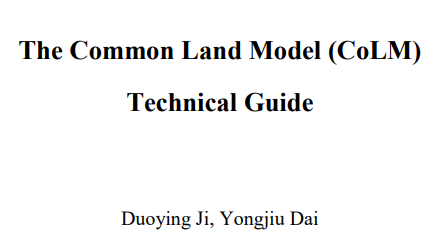Quoted from: The Common Land Model (CoLM) Version 2005 documentation and user's guide. http://globalchange.bnu.edu.cn/download/doc/CoLM/CoLM_Technical_Guide.pdf
The Community Land Model (CLM3.0) is radically different from CLM initial version, particularly from a software engineering perspective, and the great advancements in the areas of carbon cycling, vegetation dynamics, and river routing. The major differences between CLM 2.0 and CLM initial version are: 1) the biome-type land cover classification scheme was replaced with a plant functional type (PFT) representation with the specification of PFTs and leaf area index from satellite data; 2) the parameterizations for vegetation albedo and vertical burying of vegetation by snow; 3) canopy scaling, leaf physiology, and soil water limitations on photosynthesis to resolve deficiencies indicated by the coupling to a dynamic vegetation model; 4) vertical heterogeneity in soil texture was implemented to improve coupling with a dust emission model; 5) a river routing model was incorporated to improve the fresh water balance over oceans; 6) numerous modest changes were made to the parameterizations to conform to the strict energy and water balance requirements of CCSM; 7) Further substantial software development was also required to meet coding standards. Besides the changes from a software engineering perspective, the differences between CLM3.0 and CLM2.0 are: 1) several improvements to biogeophysical parameterizations to correct deficiencies; 2) stability terms were added to the formulation for 2-m air temperature to correct this; 3) the equation was modified to correct a discontinuity in the equation that relates the bulk density of newly fallen snow to atmospheric temperature; 4) a new formulation was implemented that provides for variable aerodynamic resistance with canopy density; 5) the vertical distribution of lake layers was modified to allow for more accurate computation of ground heat flux; 6) a fix was implemented for negative round-off level soil ice caused by sublimation; 7) a fix was implemented to correct roughness lengths for non-vegetated areas. Documentation for the Community Land Model (CLM3.0) was provided by Oleson et al. (2004). The simulations of CLM2.0 coupling with the Community Climate are described in Bonan et al. (2002). The simulations of CLM3.0 with the Community Climate System Model (CCSM3.0) are summarized in the Special Issue of Journal of Climate by Dickinson et al. (2005), Bonan and S. Levis (2005).
Concurrent with the development of the Community Land Model, the CLM initial version was undergoing further development at Georgia Institute of Technology and Beijing Normal University in leaf temperature, photosynthesis and stomatal calculation. Big-leaf treatment by CLM initial version and CLM3.0 that treat a canopy as a single leaf tend to overestimate fluxes of CO2 and water vapor. Models that differentiate between sunlit and shaded leaves largely overcome these problems. A one-layered, two-big-leaf submodel for photosynthesis, stomatal conductance, leaf temperature, and energy fluxes was necessitated to the CLM initial version, that is not in the CLM3.0. It includes 1) an improved two stream approximation model of radiation transfer of the canopy, with attention to singularities in its solution and with separate integrations of radiation absorption by sunlit and shaded fractions of canopy; 2) a photosynthesis–stomatal conductance model for sunlit and shaded leaves separately, and for the simultaneous transfers of CO2 and water vapor into and out of the leaf—leaf physiological properties (i.e., leaf nitrogen concentration, maximum potential electron transport rate, and hence photosynthetic capacity) vary throughout the plant canopy in response to the radiation–weight time-mean profile of photosynthetically active radiation (PAR), and the soil water limitation is applied to both maximum rates of leaf carbon uptake by Rubisco and electron transport, and the model scales up from leaf to canopy separately for all sunlit and shaded leaves; 3) a well-built quasi-Newton–Raphson method for simultaneous solution of temperatures of the sunlit and shaded leaves. For avoiding confusion with the Community Land Model (CLM2.0, CLM3.0 versions), we name this improved version of the Common Land Model as CoLM.
This was same as model now supported at NCAR. NCAR made extensive modifications mostly to make more compatible with NCAR CCM but some for better back compatibility with previous work with NCAR LSM. For purpose of using in a variety of other GCMs and mesoscale models, this adds a layer of complexity that may be unnecessary. Thus we have continued testing further developments with CLM initial version. Some changes suggested by Land Model working groups of CCSM are also implemented, such as, stability terms to the formulation for 2-m air temperature, a new formulation for variable aerodynamic resistance with canopy density. CoLM is radically different from either CLM initial version or CLM2.0 or CLM3.0, the differences could be summarized as follows,
1) Two big leaf model for leaf temperatures, photosynthesis-stomatal resistance;
2) Two-stream approximation for canopy albedoes calculation with the solution for singularity point, and the calculations for radiation for the separated canopy (sunlit and shaded);
3) New numerical scheme of iteration for leaf temperatures calculation;
4) New treatment for canopy interception with the consideration of the fraction of convection and large-scale precipitation;
5) Soil thermal and hydrological processes with the consideration of the depth to bedrock;
6) Surface runoff and sub-surface runoff;
7) Rooting fraction and the water stress on transpiration;
8) Use a grass tile 2m height air temperature in place of an area average for matching the routine meteorological observation;
9) Perfect energy and water balance within every time-step;
10) A slab ocean-sea ice model;
11) Totally CoLM coding structure.
The development of CoLM is trying to provide a version for public use and further development, and share the improvement contributed by many groups.
The source code and datasets required to run the CoLM in offline mode can be obtained via the web from: http://globalchange.bnu.edu.cn/research/models








